Memoir of John Shakespear Bartley, 1916-1919 - Part 6
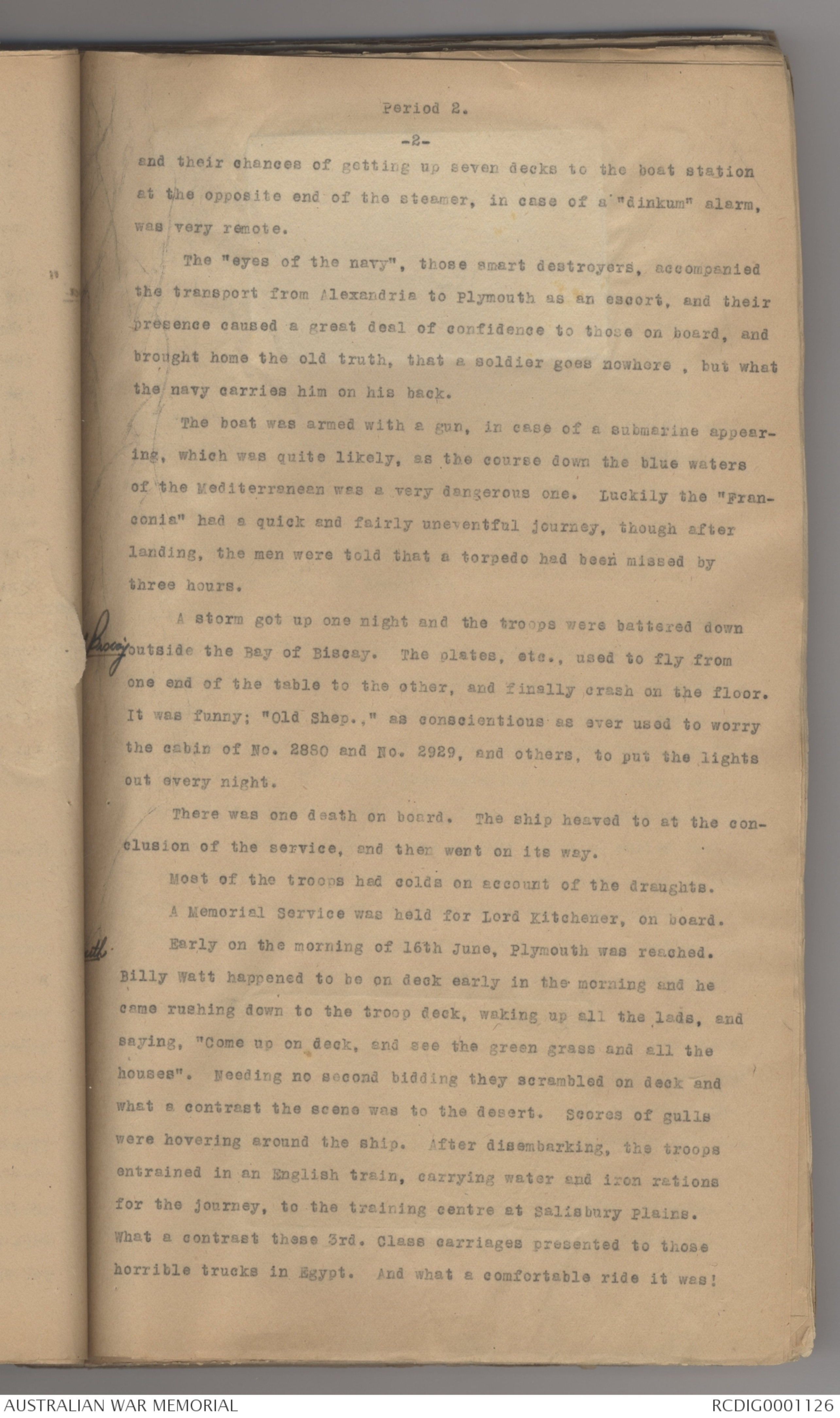
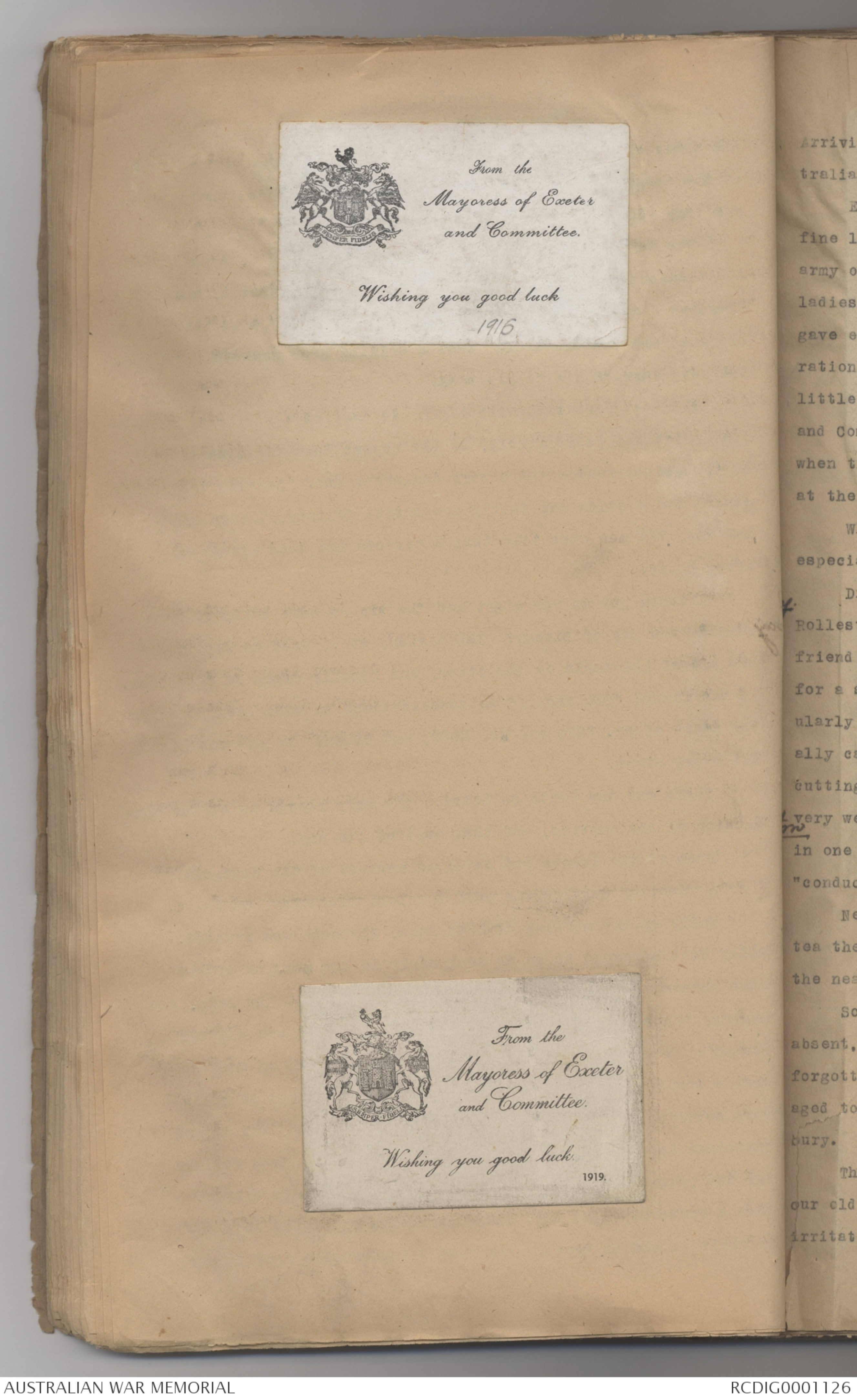
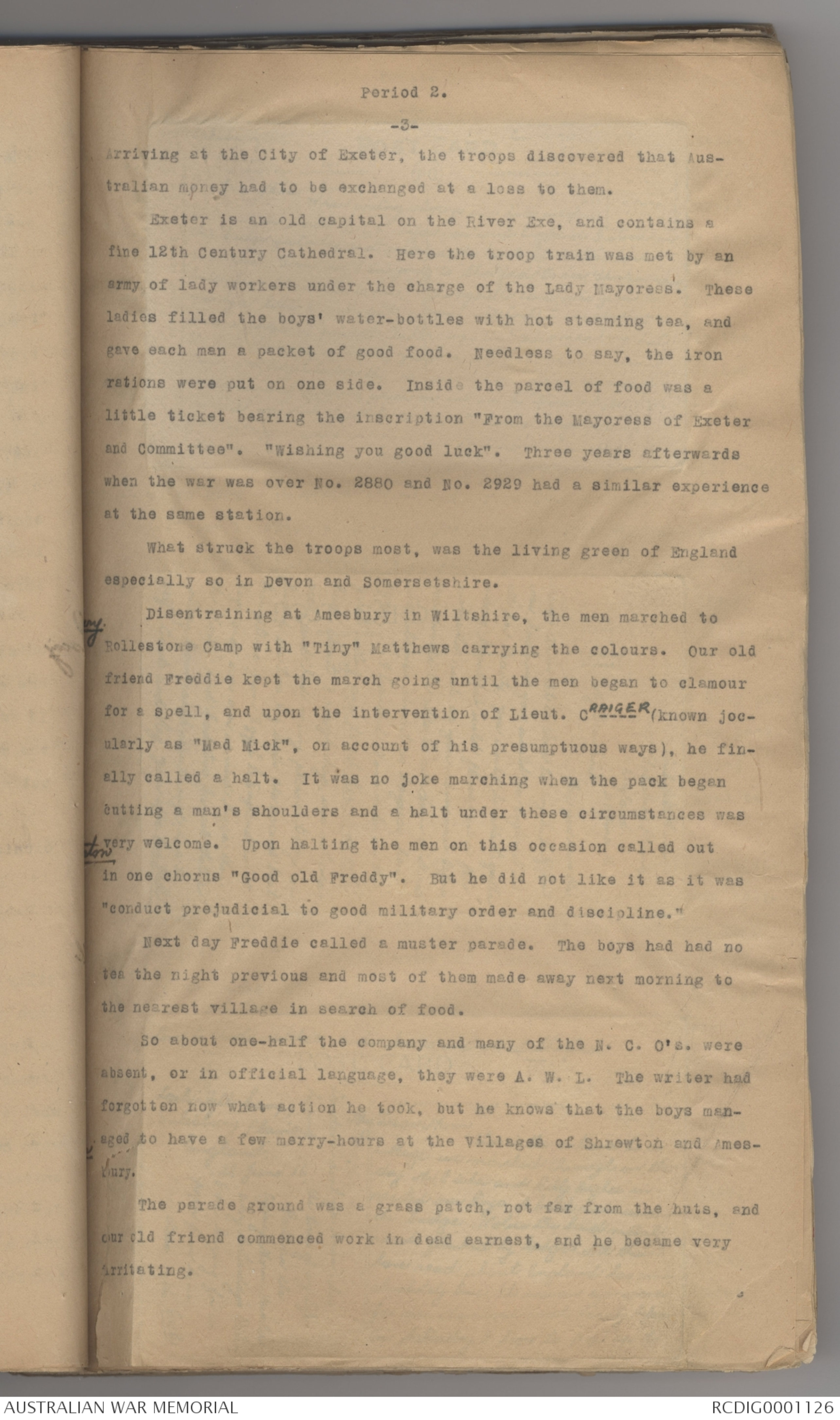
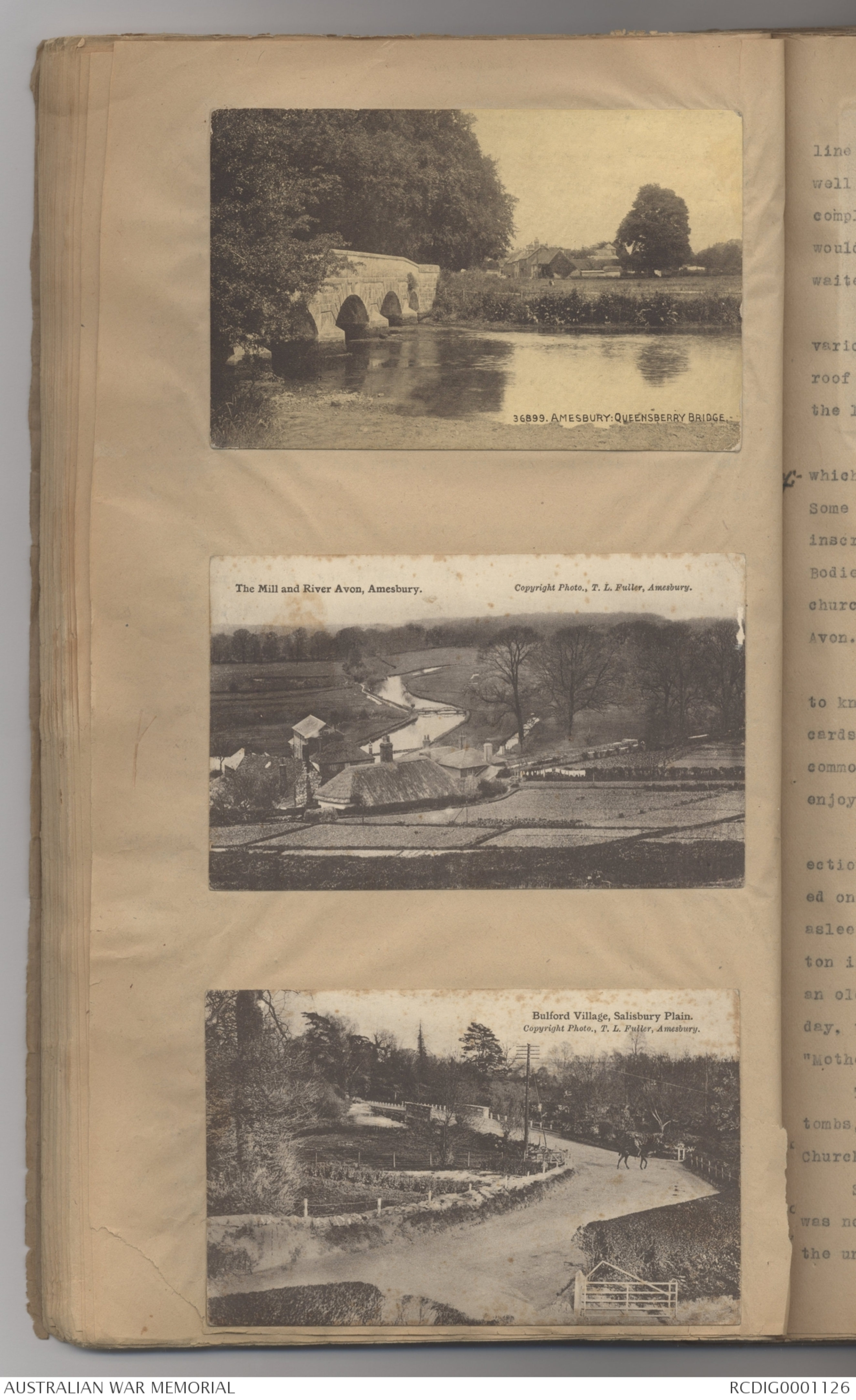
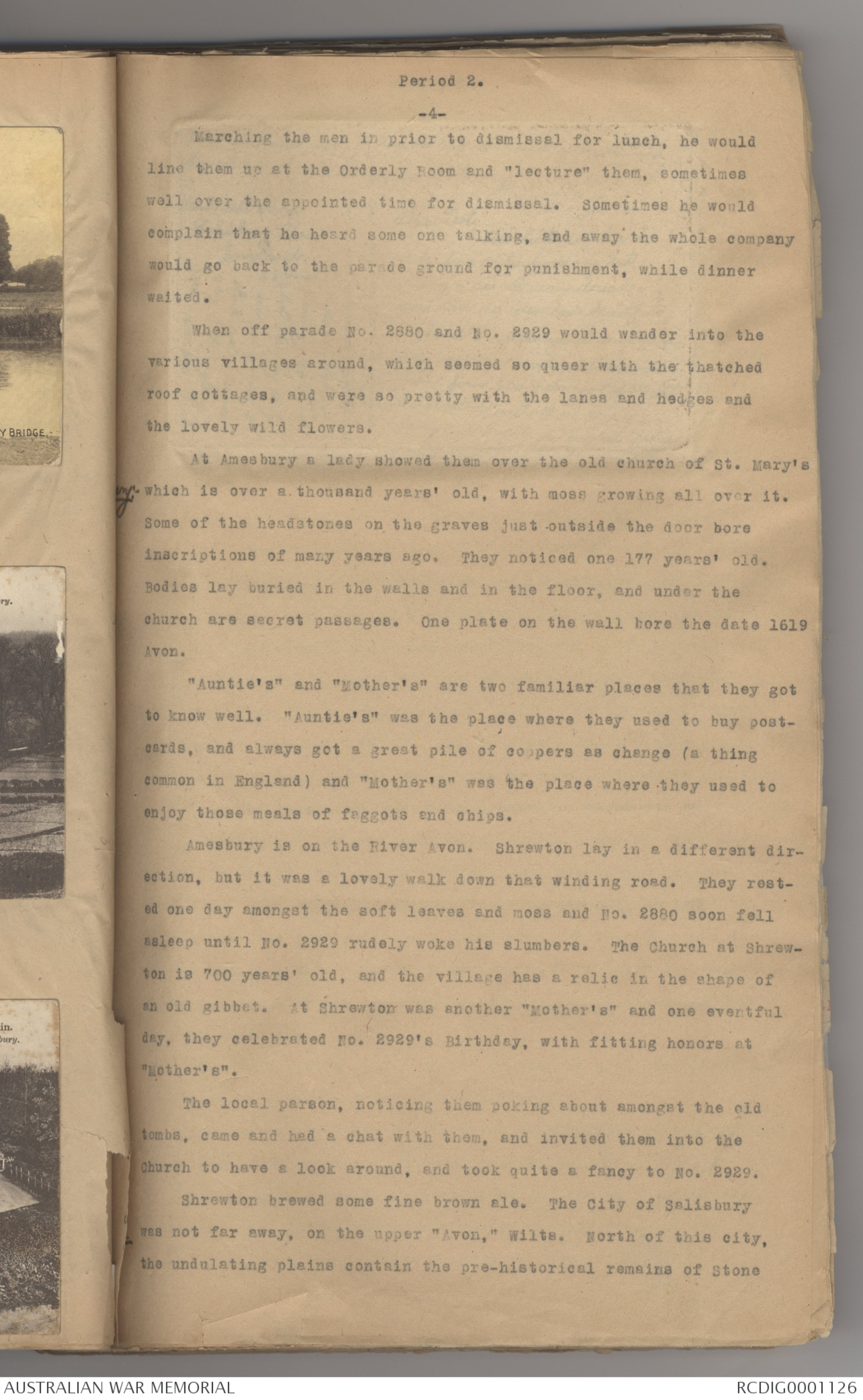
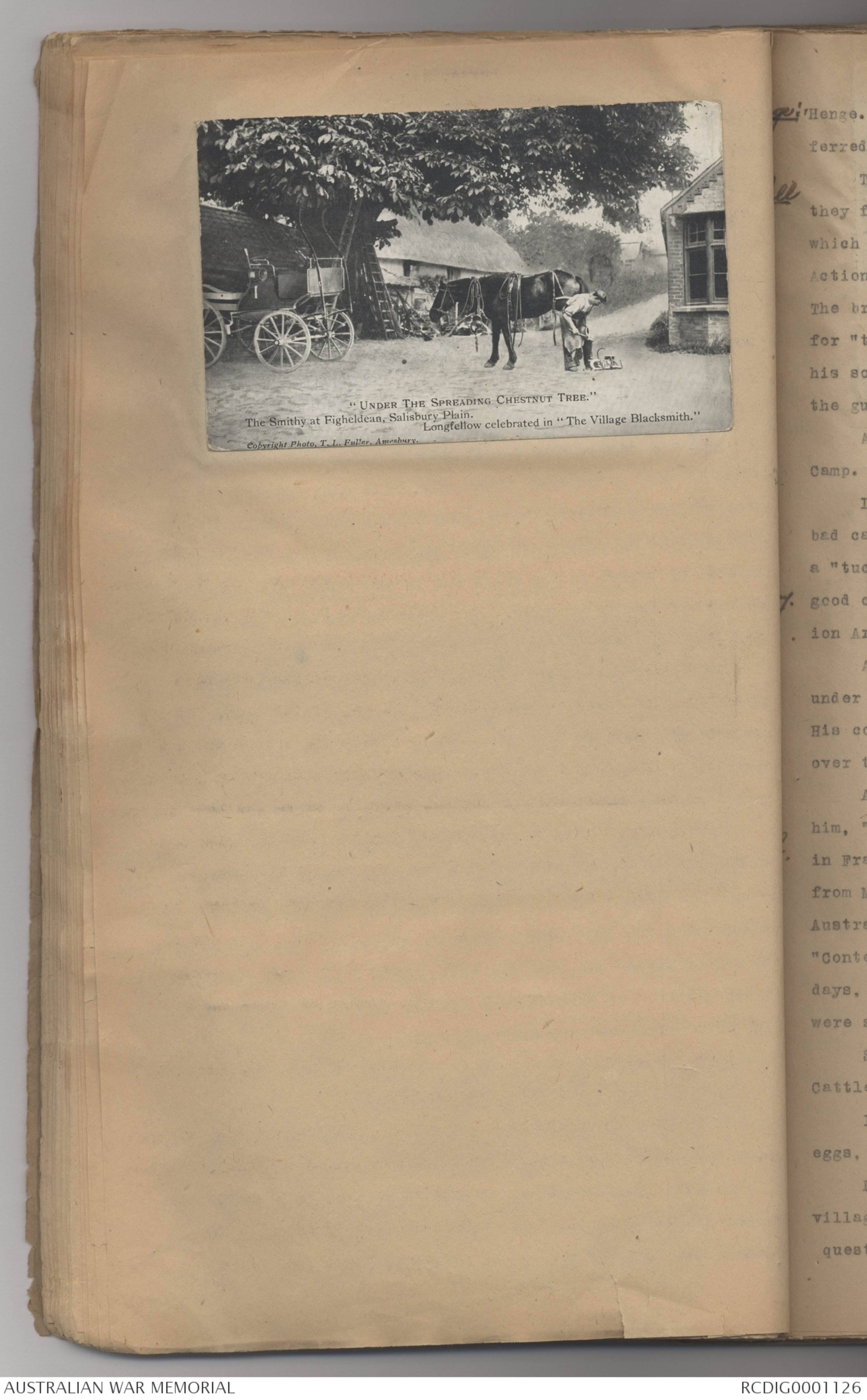
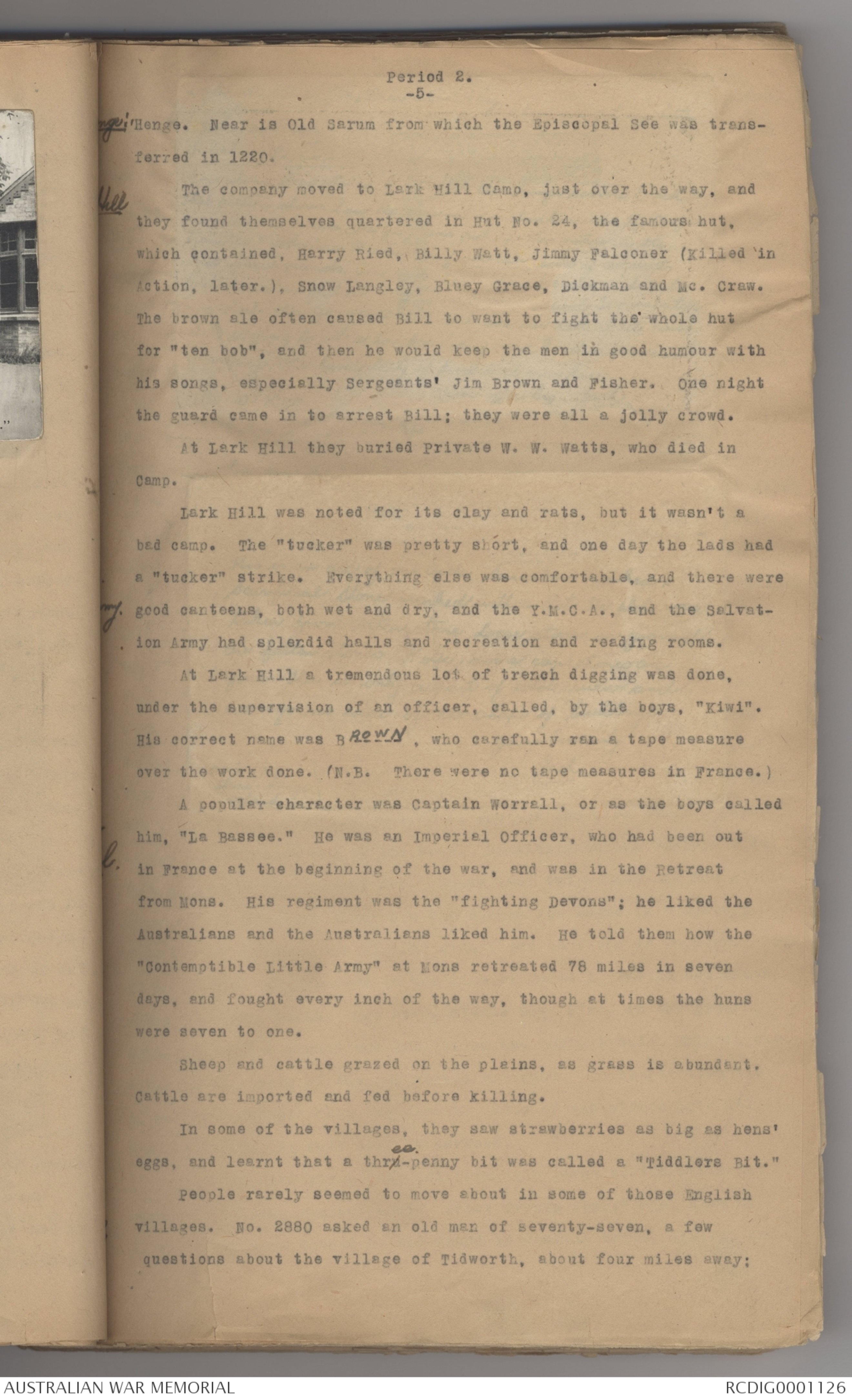
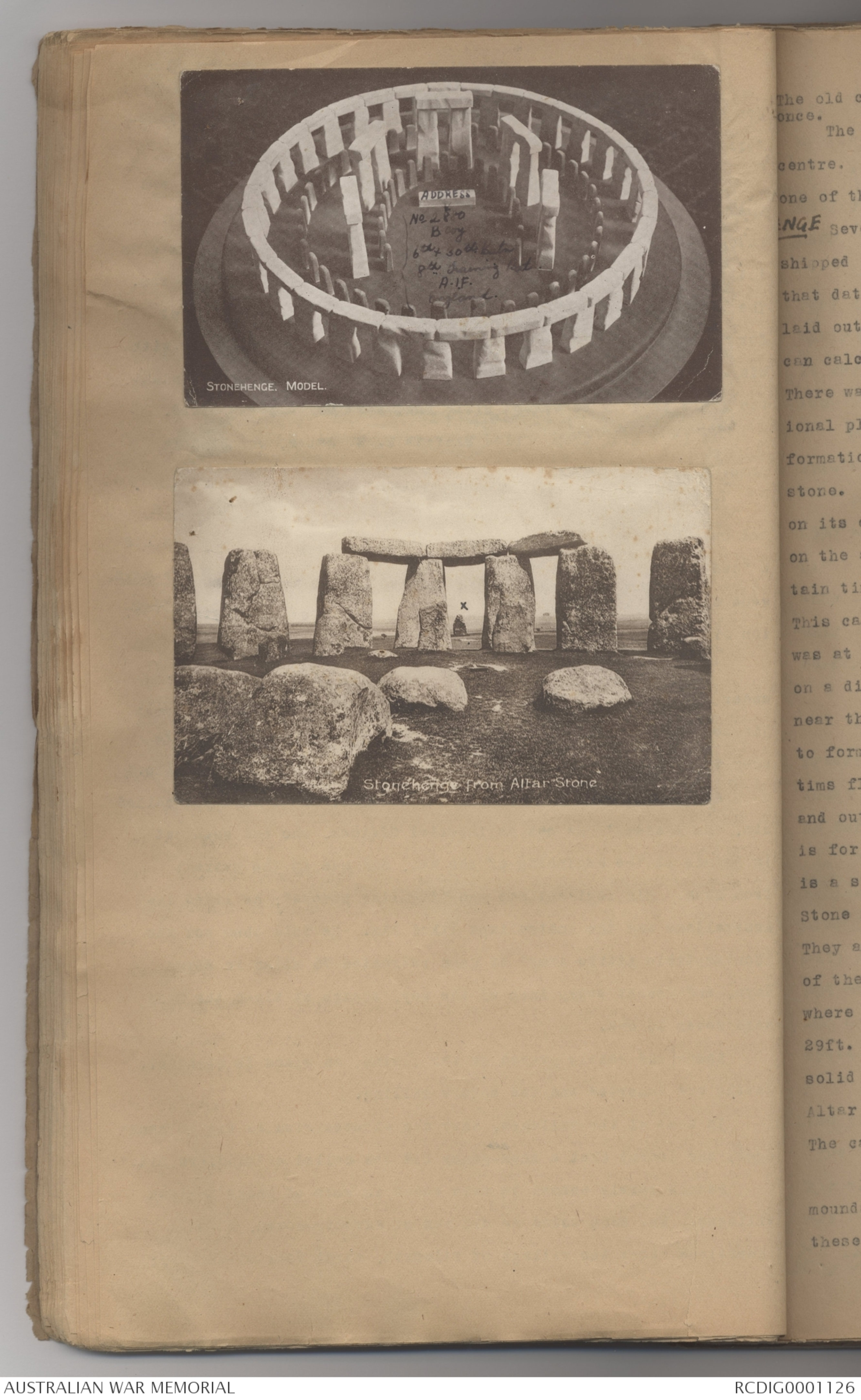
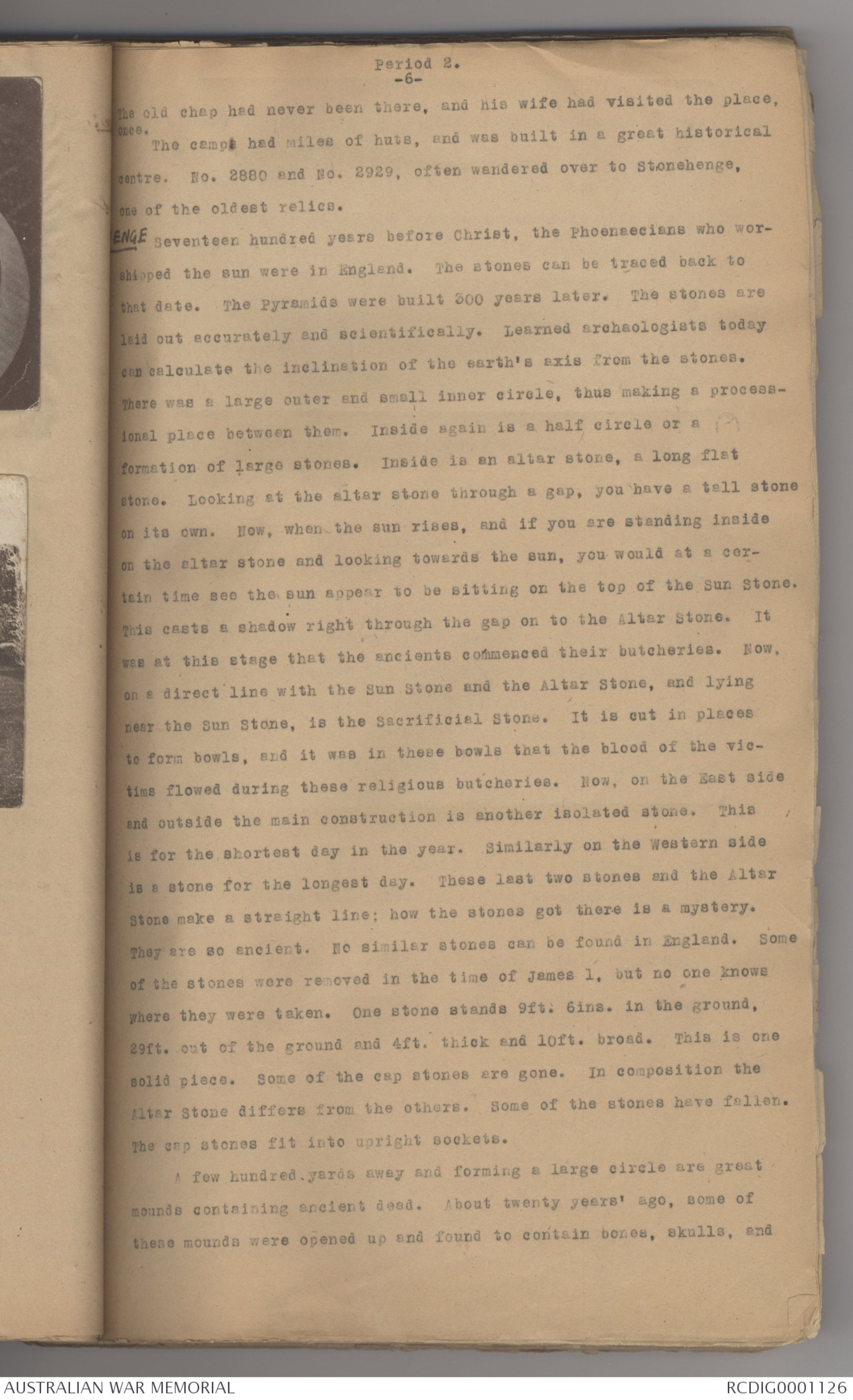
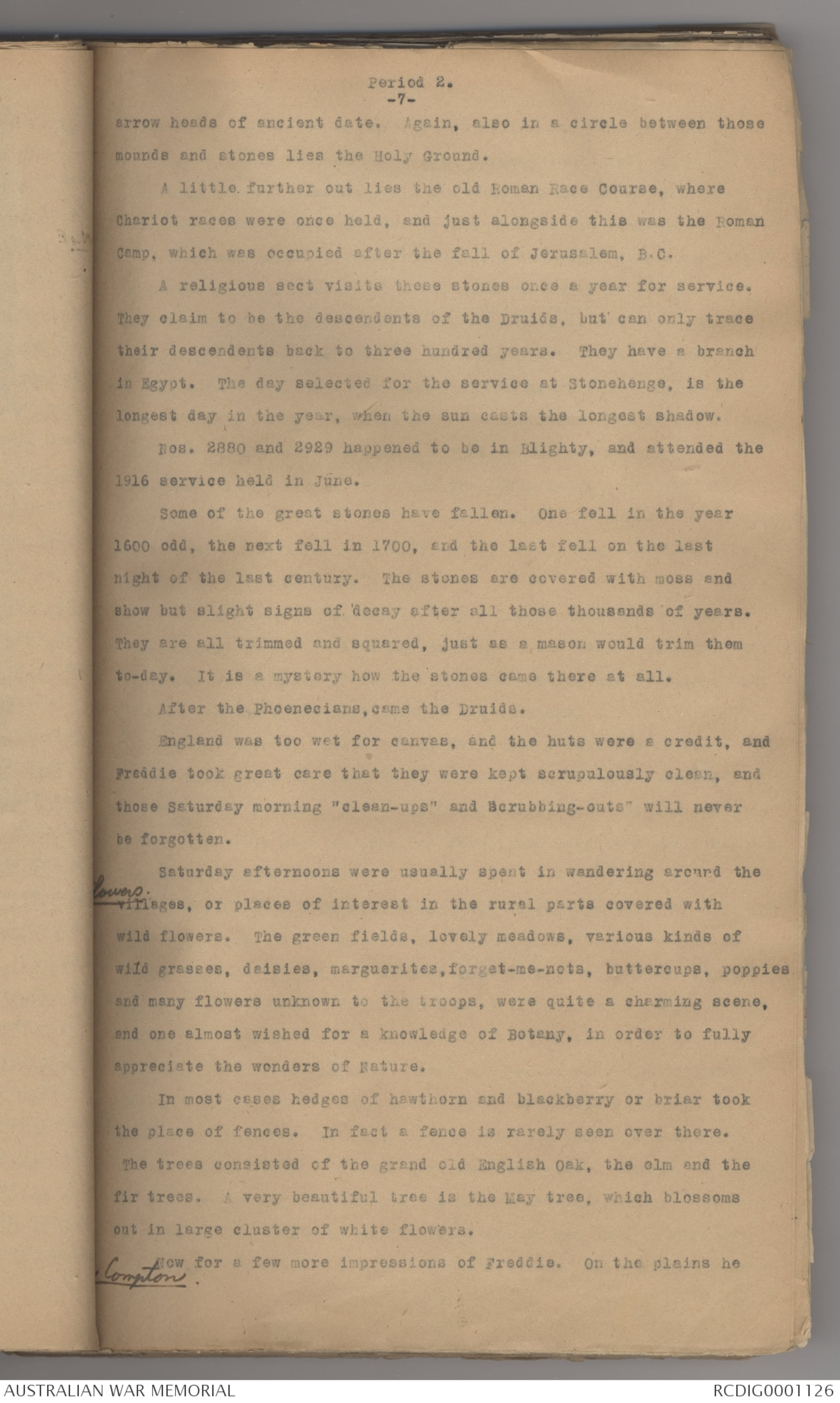
Period 2.
-2-
and their chances of getting up seven decks to the boat station
at the opposite end of the steamer, in case of a "dinkum" alarm,
was very remote.
The "eyes of the navy", those smart destroyers, accompanied
the transport from Alexandria to Plymouth as an escort, and their
presence caused a great deal of confidence to those on board, and
brought home the old truth, that a soldier goes nowhere, but what
the navy carries him on his back.
The boat was armed with a gun, in case of a submarine appearing,
which was quite likely, as the course down the blue waters
of the Mediterranean was a very dangerous one. Luckily the "Franconia"
had a quick and fairly uneventful journey, though after
landing, the men were told that a torpedo had been missed by
three hours.
A storm got up one night and the troops were battered down
[*[[?]]*Biscay*] outside the Bay of Biscay. The plates, etc., used to fly from
one end of the table to the other, and finally crash on the floor.
It was funny; "Old Shep.," as conscientious as ever used to worry
the cabin of No. 2880 and No. 2929, and others, to put the lights
out every night.
There was one death on board. The ship heaved to at the conclusion
of the service, and then went on its way.
Most of the troops had colds on account of the draughts.
A Memorial Service was held for Lord Kitchener, on board.
Early on the morning of 16th June, Plymouth was reached.
[*[[Plymouth.?]]*] Billy Watt happened to be on deck early in the morning and he
came rushing down to the troop deck, waking up all the lads, and
saying, "Come up on deck, and see the green grass and all the
houses". Needing no second bidding they scrambled on deck and
what a contrast the scene was to the desert. Scores of gulls
were hovering around the ship. After disembarking, the troops
entrained in an English train, carrying water and iron rations
for the journey, to the training centre at Salisbury Plains.
What a contrast these 3rd. Class carriages presented to those
horrible trucks in Egypt. And what a comfortable ride it was!
From the
Mayoress of Exeter
and Committee
Wishing you good luck
[*1916*]
From the
Mayoress of Exeter
and Committee
Wishing you good luck
1919.
Period 2.
-3-
Arriving at the City of Exeter, the troops discovered that Australian
money had to be exchanged at a loss to them.
Exeter is an old capital on the River Exe, and contains a
fine 12th Century Cathedral. Here the troop train was met by an
army of lady workers under the charge of the Lady Mayoress. These
ladies filled the boys' water-bottles with hot steaming tea, and
gave each man a packet of good food. Needless to say, the iron
rations were put on one side. Inside the parcel of food was a
little ticket bearing the inscription "From the Mayoress of Exeter
and Committee". "Wishing you good luck". Three years afterwards
when the war was over No. 2880 and No. 2929 had a similar experience
at the same station.
What struck the troops most, was the living green of England
especially so in Devon and Somersetshire.
Disentraining at Amesbury in Wiltshire, the men marched to
[*[[ay?]]*] Rollestone Camp with "Tiny" Matthews carrying the colours. Our old
friend Freddie kept the march going until the men began to clamour
for a spell, and upon the intervention of Lieut. CRAIGER (known jocularly
as "Mad Mick", on account of his presumptuous ways), he finally
called a halt. It was no joke marching when the pack began
cutting a man's shoulders and a halt under these circumstances was
very welcome. Upon halting the men on this occasion called out
[*[[ton?]]*] in one chorus "Good old Freddy". But he did not like it as it was
"conduct prejudicial to good military order and discipline."
Next day Freddie called a muster parade. The boys had had no
tea the night previous and most of them made away next morning to
the nearest village in search of food.
So about one-half the company and many of the N. C. O's. were
absent, or in official language, they were A. W. L. The writer had
forgotten now what action he took, but he knows that the boys managed
to have a few merry-hours at the Villages of Shrewton and Amesbury.
The parade ground was a grass patch, not far from the huts, and
our old friend commenced work in dead earnest, and he became very
irritating.
36899. AMESBURY:QUEENSBERRY BRIDGE
Photograph - see original document
The Mill and the River Avon, Amesbury
Photograph - see original document
Bulford Village, Salisbury Plain.
Photograph - see original document
Period 2.
-4-
Marching the men in prior to dismissal for lunch, he would
line them up at the Orderly Room and "lecture" them, sometimes
well over the appointed time for dismissal. Sometimes he would
complain that he heard some one talking, and away the whole company
would go back to the parade ground for punishment, while dinner
waited.
When off parade No. 2880 and No. 2929 would wander into the
various villages around, which seemed so queer with the thatched
roof cottages, and were so pretty with the lanes and hedges and
the lovely wild flowers.
At Amesbury a lady showed them over the old church of St. Mary's
[*[[ny:-?]]*] which is over a thousand years' old, with moss growing all over it.
Some of the headstones on the graves just outside the door bore
inscriptions of many years ago. They noticed one 177 years' old.
Bodies lay buried in the walls and in the floor, and under the
church are secret passages. One plate on the wall bore the date 1619
Avon.
"Auntie's" and "Mother's" are two familiar places that they got
to know well. "Auntie's" was the place where they used to buy postcards,
and always got a great pile of coppers as change (a thing
common in England) and "Mother's" was the place where they used to
enjoy those meals of faggots and chips.
Amesbury is on the River Avon. Shrewton lay in a different direction,
but it was a lovely walk down that winding road. They rested
one day amongst the soft leaves and moss and No. 2880 soon fell
asleep until No. 2929 rudely woke his slumbers. The Church at Shrewton
is 700 years' old, and the village has a relic in the shape of
an old gibbet. At Shrewton was another "Mother's" and one eventful
day, they celebrated No. 2929's Birthday, with fitting honors at
"Mother's".
The local parson, noticing them poking about amongst the old
tombs, came and had a chat with them, and invited them into the
Church to have a look around, and took quite a fancy to No. 2929.
Shrewton brewed some fine brown ale. The city of Salisbury
was not far away, on the upper "Avon," Wilts. North of this city,
the undulating plains contain the pre-historical remains of Stone
"UNDER THE SPREADING CHESTNUT TREE."
Photograph - see original document
Period 2.
-5-
[*[[nge:?]]*]Henge. Near is Old Sarum from which the Episcopal See was transferred
in 1220.
The company moved to Lark Hill Camp, just over the way, and
[*[[Hill?]]*] they found themselves quartered in Hut No. 24, the famous hut.
which contained, Harry Ried, Billy Watt, Jimmy Falconer (Killed in
Action, later.), Snow Langley, Bluey Grace, Dickman and Mc. Craw.
The brown ale often caused Bill to want to fight the whole hut
for "ten bob", and then he would keep the men in good humour with
his songs, especially Sergeants' Jim Brown and Fisher. One night
the guard came in to arrest Bill; they were all a jolly crowd.
At Lark Hill they buried Private W. W. Watts, who died in
Camp.
Lark Hill was noted for its clay and rats, but it wasn't a
bad camp. The "tucker" was pretty short, and one day the lads had
a "tucker" strike. Everything else was comfortable, and there were
[*[[ny.?]]*] good canteens, both wet and dry, and the Y.M.C.A., and the Salvation
Army had splendid halls and recreation and reading rooms.
At Lark Hill a tremendous lot of trench digging was done,
under the supervision of an officer, called, by the boys, "Kiwi".
His correct name was BROWN, who carefully ran a tape measure
over the work done. (N.B. There were no tape measures in France.)
A popular character was Captain Worrall, or as the boys called
him, "La Bassee." He was an Imperial Officer, who had been out
[*[[b.?]]*] in France at the beginning of the war, and was in the Retreat
from Mons. His regiment was the "fighting Devons"; he liked the
Australians and the Australians liked him. He told them how the
"Contemptible Little Army" at Mons retreated 78 miles in seven
days, and fought every inch of the way, though at times the huns
were seven to one.
Sheep and cattle grazed on the plains, as grass is abundant.
Cattle are imported and fed before killing.
In some of the villages, they saw strawberries as big as hens'
eggs, and learnt that a thruee-penny bit was called a "Tiddlers Bit."
People rarely seemed to move about in some of those English
villages. No. 2880 asked an old man of seventy-seven, a few
questions about the village of Tidworth, about four miles away;
STONEHENGE. MODEL
Photograph - see original document
Stonehenge from Altar Stone
Photograph - see original document
Period 2.
-6-
The old chap had never been there, and his wife had visited the place,
once.
The camps had miles of huts, and was built in a great historical
centre. No. 2880 and No. 2929, often wandered over to Stonehenge,
one of the oldest relics.
[*[[ENGE?]]*] Seventeen hundred years before Christ, the Phoenaecians who worshipped
the sun were in England. The stones can be traced back to
that date. The Pyramids were built 300 years later. The stones are
laid out accurately and scientifically. Learned archaologists today
can calculate the inclination of the earth's axis from the stones.
There was a large outer and small inner circle, thus making a processional
place between them. Inside again is a half circle or a
formation of large stones. Inside is an altar stone, a long flat
stone. Looking at the altar stone through a gap, you have a tall stone
on its own. Now, when the sun rises, and if you are standing inside
on the altar stone and looking towards the sun, you would at a certain
time see the sun appear to be sitting on the top of the Sun Stone.
This casts a shadow right through the gap on to the Altar Stone. It
was at this stage that the ancients commenced their butcheries. Now,
on a direct line with the Sun Stone and the Altar Stone, and lying
near the Sun Stone, is the Sacrificial Stone. It is cut in places
to form bowls, and it was in these bowls that the blood of the victims
flowed during these religious butcheries. Now, on the East side
and outside the main construction is another isolated stone. This
is for the shortest day in the year. Similarly on the Western side
is a stone for the longest day. These last two stones and the Altar
Stone make a straight line; how the stones got there is a mystery.
They are so ancient. No similar stones can be found in England. Some
of the stones were removed in the time of James 1, but no one knows
where they were taken. One stone stands 9ft. 6ins. in the ground,
29ft. out of the ground and 4ft. thick and 10ft. broad. This is one
solid piece. Some of the cap stones are gone. In composition the
Altar Stone differs from the others. Some of the stones have fallen.
The cap stones fit into upright sockets.
A few hundred. yards away and forming a large circle are great
mounds containing ancient dead. About twenty years' ago, some of
these mounds were opened up and found to contain bones, skulls, and
Period 2.
-7-
arrow heads of ancient date. Again, also in a circle between those
mounds and stones lies the Holy Ground.
A little further out lies the old Roman Race Course, where
Chariot races were once held, and just alongside this was the Roman
Camp, which was occupied after the fall of Jerusalem, B.C.
A religious sect visits these stones once a year for service.
They claim to be the descendents of the Druids, but can only trace
their descendents back to three hundred years. They have a branch
in Egypt. The day selected for the service at Stonehenge, is the
longest day in the year, when the sun casts the longest shadow.
Nos. 2880 and 2929 happened to be in Blighty, and attended the
1916 service held in June.
Some of the great stones have fallen. One fell in the year
1600 odd, the next fell in 1700, and the last fell on the last
night of the last century. The stones are covered with moss and
show but slight signs of decay after all those thousands of years.
They are all trimmed and squared, just as a mason would trim them
to-day. It is a mystery how the stones came there at all.
After the Phoenecians, came the Druids.
England was too wet for canvas, and the huts were a credit, and
Freddie took great care that they were kept scrupulously clean, and
those Saturday morning "clean-ups" and Scrubbing-outs" will never
be forgotten.
Saturday afternoons were usually spent in wandering around the
[*[[lowers?]]*] villages, or places of interest in the rural parts covered with
wild flowers. The green fields, lovely meadows, various kinds of
wild grasses, daisies, marguerites, forget-me-nots, buttercups, poppies
and many flowers unknown to the troops, were quite a charming scene,
and one almost wished for a knowledge of Botany, in order to fully
appreciate the wonders of Nature.
In most cases hedges of hawthorn and blackberry or briar took
the place of fences. In fact a fence is rarely seen over there.
The trees consisted of the grand old English Oak, the elm and the
fir trees. A very beautiful tree is the May tree, which blossoms
out in large cluster of white flowers.
Now for a few more impressions of Freddie. On the plains he
[*Compton.*]
 Ray Stenhouse
Ray StenhouseThis transcription item is now locked to you for editing. To release the lock either Save your changes or Cancel.
This lock will be automatically released after 60 minutes of inactivity.